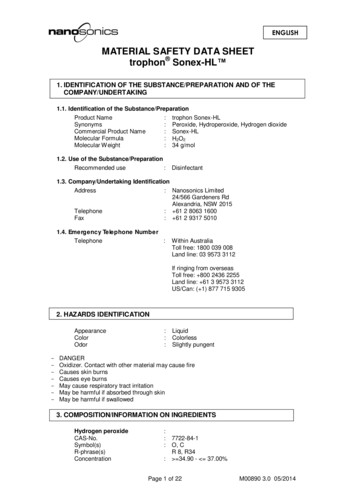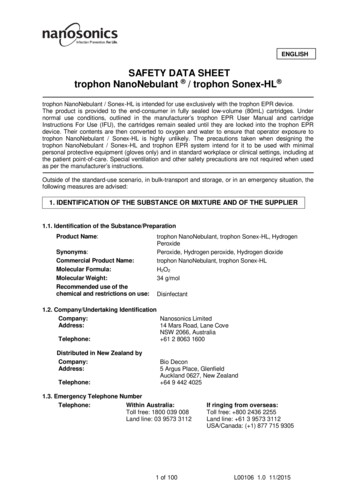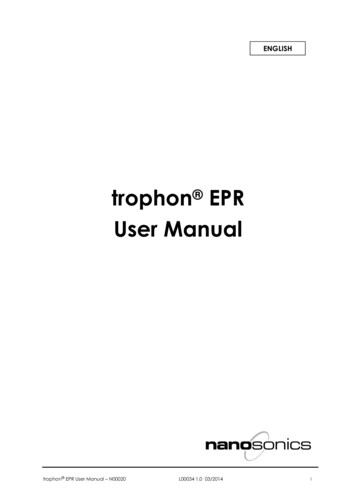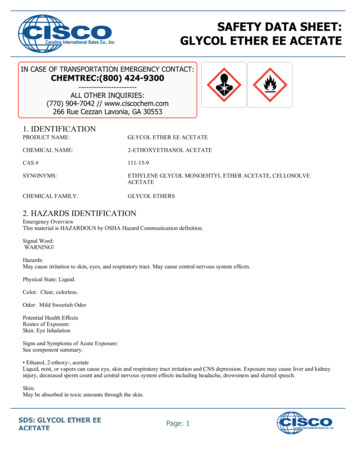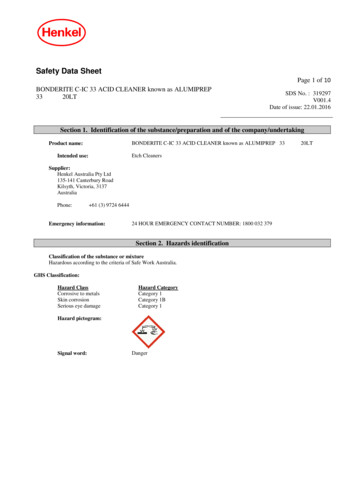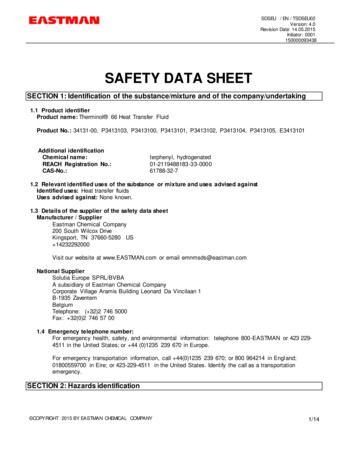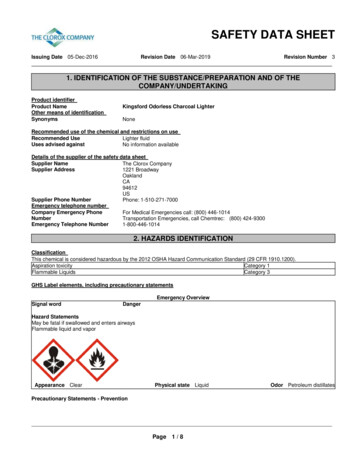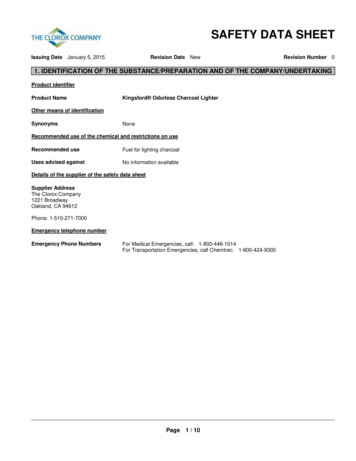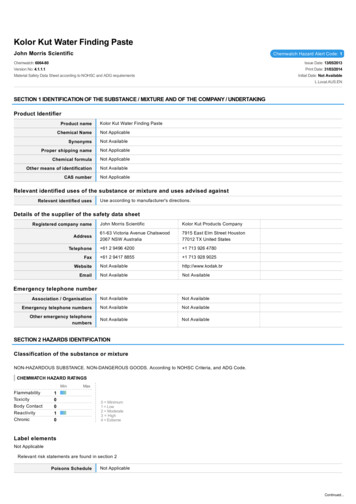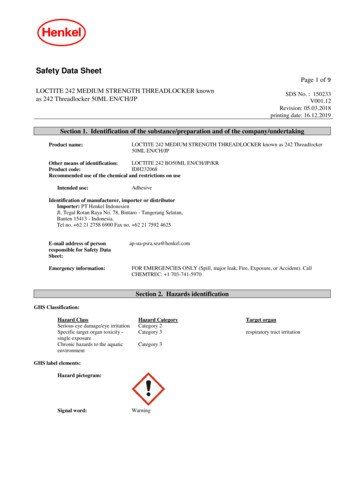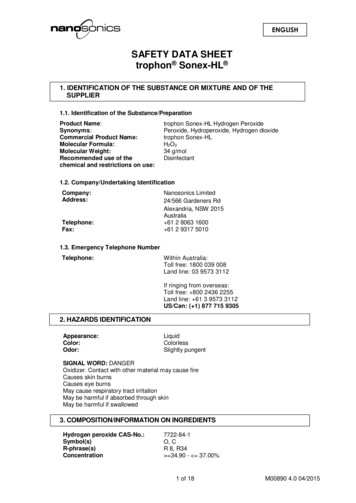
Transcription
ENGLISHSAFETY DATA SHEETtrophon Sonex-HL 1. IDENTIFICATION OF THE SUBSTANCE OR MIXTURE AND OF THESUPPLIER1.1. Identification of the Substance/PreparationProduct Name:Synonyms:Commercial Product Name:Molecular Formula:Molecular Weight:Recommended use of thechemical and restrictions on use:trophon Sonex-HL Hydrogen PeroxidePeroxide, Hydroperoxide, Hydrogen dioxidetrophon Sonex-HLH2O234 g/molDisinfectant1.2. Company/Undertaking nics Limited24/566 Gardeners RdAlexandria, NSW 2015Australia 61 2 8063 1600 61 2 9317 50101.3. Emergency Telephone NumberTelephone:Within Australia:Toll free: 1800 039 008Land line: 03 9573 3112If ringing from overseas:Toll free: 800 2436 2255Land line: 61 3 9573 3112US/Can: ( 1) 877 715 93052. HAZARDS sSlightly pungentSIGNAL WORD: DANGEROxidizer. Contact with other material may cause fireCauses skin burnsCauses eye burnsMay cause respiratory tract irritationMay be harmful if absorbed through skinMay be harmful if swallowed3. COMPOSITION/INFORMATION ON INGREDIENTSHydrogen peroxide O, CR 8, R34 34.90 - 37.00%1 of 18M00890 4.0 04/2015
4. FIRST AID MEASURESInhalationRemove person to fresh air.Consult a physician if irritation occurs and persists.Eye ContactRinse immediately with plenty of water, also under the eyelids, for at least 15minutes.Get medical attention immediately.Skin ContactRemove contaminated clothing.Wash with soap and copious amount of water.Consult a physician if irritation occurs and persists.IngestionCall a poison control center or physician immediately. Do NOT induce vomiting unlessdirected by a physician.If Conscious: Rinse mouth thoroughly with water.If Unconscious: Never give anything by mouth to an unconscious person.5. FIRE FIGHTING MEASURESSuitable extinguishing mediaFlood with water.Fire / Explosion HazardsProduct is non-combustible. On decomposition releases oxygen which may intensify fire.Special protective equipment for fire-fightersIn the case of fire, wear respiratory protective equipment independent of surrounding air andchemical protective suit.Other informationEvacuate personnel to safe areas.Keep unauthorized persons away.Keep out unprotected persons.HAZCHEM Code: 2P6. ACCIDENTAL RELEASE MEASURESPersonal precautions, protective equipment and emergency proceduresProduct causes chemical burns.Wear personal protective equipment; see section 8.Evacuate personnel to safe areas.Keep out unprotected persons.Keep away from incompatible products.Environmental precautionsSmall quantities can be discharged into the sewer with large quantities of water.If the product contaminates rivers and lakes or drains inform respective authorities.2 of 18M00890 4.0 04/2015
Methods and materials for containment and cleaning upIf possible, dam large quantities of liquid with sand or earth.Dilute with plenty of water.Do not add chemical products.Never return spills to original packaging for re-use.7. HANDLING AND STORAGEPrecautions for safe handlingUse only in well-ventilated areas.Keep away from incompatible products.Prevent all contact with organics.Use only equipment and materials which are compatible with the product.Never return unused material to bottle.Ascertain that an adequate supply of water is available in the event of an accident.Conditions for safe storage, including any incompatibilitiesKeep in a cool place.Keep away from heat and direct sun-light.Keep away from incompatible products.Keep away from combustible material.Keep in original packaging, closed.Keep upright as specified on packaging.Specific use(s)Use only with the trophon EPR.Packaging materialHDPE bottle350um fibre board and ecocoteOther informationRefer to protective measures listed in section 8.8. EXPOSURE CONTROLS/PERSONAL PROTECTIONControl ParametersUS. ACGIH Threshold Limit Values 2005:TLV (NOHSC) 11/2004:TWA 1 ppmTWA 1 ppm (1.4mg/m3)Exposure controlsEnsure adequate ventilation.Refer to protective measures listed in section 8.Occupational exposure controls for spillsRespiratory protection:If workplace exposure limit is exceeded apply Respiratory protective equipment.Use only respiratory protection that conforms to the international/national standards.Hand protection:Wear suitable gloves.Recommended materials: PVC, rubberEye protection:Chemical resistant goggles must be worn.If risk of splashing, chemical proof goggles/face shield.3 of 18M00890 4.0 04/2015
Skin and body protection:Protective suit.Apron/boots of PVC or rubber if risk of splashing.Hygiene measures:Shower and eye wash stations.Handle in accordance with good hygiene and safety practice.9. PHYSICAL AND CHEMICAL PROPERTIESGeneral Information (appearance, odor)Appearance:LiquidColor:ColorlessOdor:Slightly pungentImportant Health Safety and Environmental InformationpH:1-4Boiling point/range:108 C (H2O2 35%)Flash point:Does not flash – not flammable.Flammability (solid, gas):The product is not flammable.Explosive properties:Not explosive.Oxidizing properties:Remarks: OxidizerVapor pressure:12 mbar Temperature: 20 CRemarks: Total pressure (H2O2 H2O) (H2O2 50%)72 mbar Temperature: 50 CRemarks: Total pressure (H2O2 H2O) (H2O2 50%)1 mbar Temperature: 30 CRemarks: Partial pressure (H2O2 H2O) (H2O2 50%)Relative density/ Density:Solubility:1.13 (H2O2 35%)Soluble in: WaterPolar organic solventsPartition coefficient (n- octanol/water):Log Pow: -1.1Viscosity:1.07mPa.s Temperature: 20 C (H2O2 27.5%)Vapor density:1 (H2O2 50%)Miscibility in water:Completely miscible10. STABILITY AND REACTIVITYReactivity: No information available.Chemical Stability: Stable under normal ambient and anticipated storage and handling conditionsof temperature and pressure.Possibility of hazardous reactions: None knownConditions to avoid: Direct sunlight, heat, heat effect.Incompatible materials: Contamination, impurities, metals, decomposition catalysts, reducingagents.Hazardous decomposition products: Oxygen, steam.4 of 18M00890 4.0 04/2015
11. TOXICOLOGICAL INFORMATIONToxicological dataAcute oral toxicity:LD50, rat. 1,232 mg/kg (H2O2 35%)Acute inhalation toxicity:LD50, 4h, rat, 2,000 mg/m3 (Hydrogen peroxide)LC0, 1h, mouse, 2,170 mg/m3 (Hydrogen peroxide)Acute dermal toxicity:LD50, rabbit, 2,000 mg/kg (H2O2 35%)Skin irritation:Rabbit, irritant (skin) (H2O2 50%)Eye irritation:Rabbit, Risk of serious damage to eyes. (H2O2 35%)Sensitization:Guinea pig: not sensitizingChronic toxicity:Oral, prolonged exposure, rat/mouse, Target Organs: gastro-intestinal system, observed effectCarcinogenicity:Oral, Prolonged exposure, mouse, Target organs; duodenum, carcinogenic effectGenetic toxicity in vitro:In vitro, without metabolic activation, mutagenic effects.Genetic toxicity in vivo:In vivo, animal testing did not show any mutagenic effects.Health effectsInhalation:Irritation to respiratory tract and cause inflammation of the respiratory tract and pulmonary oedema.Eye contact:Extreme irritation, watering, redness and swelling of the eyelids.Risk of irreversible damage.Skin contact:Causes caustic burns.Irritation and temporary whitening at contact area.Ingestion:May lead to bleeding of the mucosa in the mouth, oesophagus and stomach.May be fatal if swallowed.12. ECOLOGICAL INFORMATIONEcotoxicity effectsAcute toxicity:Fishes, Pimephales promelas, LC50, 96h, 16.4 mg/lFishes, Pimephales promelas, NOEC, 96h, 5 mg/lCrustaceans, Daphnia pulex, EC50, 48h, 2.4 mg/lCrustaceans, Daphnia pulex, NOEC, 48h, 1 mg/lChronic toxicity:Remarks: no data availableAlgae, various species, EC50, from 72 – 96h, from 3.7 – 160 mg/lRemarks: fresh waterAlgae, Nitzchia closterium, EC50, from 72 – 96, 0.85 mg/lRemarks: salt water13. DISPOSAL CONSIDERATIONSWaste from residues / unused productsIn accordance with local and national regulations.Large quantities: Contact manufacturer5 of 18M00890 4.0 04/2015
Packaging treatmentIn accordance with local and national regulations.14. TRANSPORT INFORMATIONMode of transport: Sea, road and rail.Mode of transport to avoid: Air – STRICTLY NO AIR FREIGHT.Other information:UN-No:Transport Hazard Class:Subrisk 1:Packing Group:Proper Shipping Name or Technical Name:Marine Pollutant:IMO Labels:ADG Labels:IMDG EMS Fire:IMDG EMS Spill:HAZCHEM Code:20145.1 Oxidizing Agent8 CorrosiveIIHYDROGEN PEROXIDE, AQUEOUSSOLUTIONNoOXIDISING AGENT CORROSIVE5.1 8F-HS-Q2P15. REGULATORY INFORMATIONLabelHazardous components which must be listed on the label: Hydrogen peroxideSymbol(s)R-phrase(s)CCauses burnsS1/2Keep locked up and out of the reach of childrenS3S-phrase(s)CorrosiveR34S28S36/39S45Keep in a cool placeAfter contact with skin, wash immediately with plenty of water.Wear suitable protective clothing and eye/face protectionIn case of accident or if you feel unwell, seek medical adviceimmediately (show the label where possible)International InventoriesToxic Substance Control Act list (TSCA)Australian Inventory of Chemical Substances(AICS)In compliance with inventory.EU list of existing chemical substances(EINECS)In compliance with inventory.New Zealand Inventory (in preparation) (NZ)One or more components not listed oninventory.In compliance with inventory.16. OTHER INFORMATIONThe information provided in this Material Safety Data Sheet is correct to the best of ourknowledge, information and belief at the date of its publication. The information given is designedonly as guidance for safe handling, use, processing, storage, transportation, disposal and releaseand is not to be considered a warranty or quality specification. This applies to the product whichconforms to the specification, unless otherwise stated.Reason for issue: Alignment to GHS requirements6 of 18M00890 4.0 04/2015
FRANÇAISFICHE DE DONNÉES DE SÉCURITÉtrophon Sonex-HL 1. IDENTIFICATION DE LA SUBSTANCE/PRÉPARATION ET DE LASOCIÉTÉ/ENTREPRISE1.1. Identification de la ation commercialeFormule moléculaireMasse moléculaireUtilisation recommandée du produitchimique et restrictions en matièred'utilisation :trophon Sonex-HL peroxyde d'hydrogènedioxyde d'hydrogène, bioxyde d'hydrogène, eauoxygénéetrophon Sonex-HLH2O234 g/moldésinfectant1.2. Identification de la société/entrepriseEntreprise :Adresse :Nanosonics Limited24/566 Gardeners RdAlexandria, NSW 2015Australie 61 2 8063 1600 61 2 9317 5010Téléphone :Fax :1.3. Numéro d'urgenceTéléphone :En AustralieNuméro gratuit : 1800 039 008Numéro payant : 03 9573 3112De l'étrangerNuméro gratuit : 800 2436 2255Numéro payant : 61 3 9573 3112États-Unis/Canada : ( 1) 877 715 93052. IDENTIFICATION DES DANGERSAspectliquideCouleur :Odeur :incolorelégèrement âcreMENTION D’AVERTISSEMENT : DANGERAgent oxydant : le contact avec tout autre matériau peut provoquer un incendie.Provoque des brûlures cutanées.Provoque des brûlures oculaires.Peut irriter les voies respiratoires.Peut être nocif en cas d'absorption cutanée.Peut être nocif en cas d'ingestion.3. COMPOSITION/INFORMATIONS SUR LES COMPOSANTSPeroxyde d'hydrogène nº CAS :Symbole(s)Phrases de risqueConcentration7722-84-1O, CR 8, R 34 34,90 - 37,00 %7 of 18M00890 4.0 04/2015
4. PREMIERS SECOURSEn cas d'inhalationTransporter la victime immédiatement à l'air frais.Consulter un médecin en cas d'irritation persistante.En cas de projection dans les yeuxSe rincer immédiatement les yeux à grande eau, y compris sous les paupières,pendant au moins 15 minutes.Consulter un médecin immédiatement.En cas de contact avec la peauEnlever les vêtements contaminés.Laver la peau avec du savon et rincer à grande eau.Consulter un médecin en cas d'irritation persistante.En cas d'ingestionAppeler un centre antipoison ou un médecin sans délai. NE PAS faire vomir sauf surindication du médecin.Si la victime est consciente : rincer la bouche abondamment à l'eau.Si la victime est inconsciente : ne jamais administrer quoi que ce soit par voie orale à unepersonne inconsciente.5. MESURES DE LUTTE CONTRE LES INCENDIESMoyen d'extinction appropriéVerser de l'eau en grande quantité.Risques d'incendie et d'explosionProduit ininflammable. Libération d'oxygène susceptible d'alimenter un incendie lors de ladécomposition du produit.Équipement de protection spécial pour les pompiersEn cas d'incendie, porter un équipement de protection respiratoire indépendant de l'air ambiant etune combinaison de protection chimique.Informations supplémentairesÉvacuer le personnel.Tenir toute personne non autorisée à l'écart.Tenir toute personne ne portant pas d'équipement de protection à l'écart.Code HAZCHEM : 2P6. MESURES À PRENDRE EN CAS DE DÉVERSEMENT ACCIDENTELPrécautions individuelles, équipement de protection et procédures d'urgenceLe produit peut provoquer des brûlures chimiques.Porter un équipement de protection individuelle ; voir section 8.Évacuer le personnel.Tenir toute personne ne portant pas d'équipement de protection à l'écart.Tenir à l'écart de produits incompatibles.Précautions environnementalesLe produit peut être rejeté dans les égouts en petite quantité s'il est dilué dans un grand volumed'eau.En cas de contamination des cours d'eau, des lacs ou des canalisations, informer les autoritéscompétentes.8 of 18M00890 4.0 04/2015
Méthodes et matériaux pour l'endiguement et le nettoyageSi possible, endiguer de grandes quantités de liquide avec du sable ou de la terre.Diluer dans un grand volume d'eau.Ne pas ajouter de produits chimiques.Ne jamais remettre de produit renversé dans l'emballage d'origine en vue de le réutiliser.7. MANIPULATION ET CONSERVATIONPrécautions d'usage pour une manipulation sans risqueUtiliser uniquement dans des endroits bien aérés.Tenir à l'écart de produits incompatibles.Éviter tout contact avec des matières organiques.Utiliser uniquement un équipement et des matériaux compatibles avec le produit.Ne jamais remettre du produit inutilisé dans la bouteille.Veiller à la disponibilité d'une quantité suffisante d'eau en cas d'accident.Conditions garantes d'un entreposage sans risque - déclinaison des incompatibilitésConserver dans un endroit fraisTenir à l'abri de la chaleur et de la lumière directe du soleil.Tenir à l'écart de produits incompatibles.Tenir à l'abri de matières inflammables.Conserver dans son emballage d'origine, fermé.Conserver en position verticale tel qu'indiqué sur l'emballage.Usage(s) spécifique(s)Utiliser avec le Trophon EPR uniquement.Matériau de l'emballageBouteille en PEHDCarton fibre de 350 micromètres et emballage EcoCoteInformations supplémentaires :Consulter les mesures de protection indiquées dans la section 8.8. CONTRÔLES D'EXPOSITION/PROTECTION INDIVIDUELLEParamètres de contrôleÉtats-Unis - Valeurs limites fixées en 2005 par l'ACGIHValeurs-seuils (NOHSC) 11/2004MPT 1 ppmMPT 1 ppmContrôles d'expositionGarantir une aération suffisante.Consulter les mesures de protection indiquées dans la section 8.Contrôles d'exposition professionnelle en cas de déversementProtection respiratoire :En cas de dépassement de la limite d'exposition sur le lieu de travail, porter un équipement deprotection respiratoire.Utiliser uniquement une protection respiratoire conforme aux normes nationales et internationales.Protection des mains :Porter des gants appropriés.Matières recommandées : PVC, caoutchoucProtection des yeux :Port de lunettes de protection résistant aux produits chimiques obligatoire.9 of 18M00890 4.0 04/2015
En cas de risque de projection, porter des lunettes ou un masque de protection résistant auxproduits chimiques.Protection de la peau et du corps :Combinaison de protection.Tablier et bottes en PVC ou en caoutchouc en cas de risque de projection.Mesures d'hygiène :Douches et laveurs d'yeux.Manipuler conformément aux règles de bonne pratique d'hygiène et de sécurité.9. PROPRIÉTÉS PHYSIQUES ET CHIMIQUESInformations générales (aspect, odeur)liquideincolorelégèrement âcreAspect :Couleur :Odeur :Informations importantes relatives à la santé, à la sécurité et à l'environnementpH :1à4Point et plage d'ébullition :(H2O2 35 %).Point d'éclair :aucun – n'est pas inflammable.Inflammabilité (état solide et gazeux) :le produit n'est pas inflammable.Propriétés explosives :aucune.Propriétés oxydantes :Remarques : agent oxydant.Pression de vapeur :12 mbar Température : 20 CRemarques : pression totale (H2O2 H2O) (H2O2 50 %)72 mbar Température : 50 CRemarques : pression totale (H2O2 H2O) (H2O2 50 %)1 mbar Température : 30 CRemarques : pression partielle (H2O2 H2O) (H2O250 %)Densité relative et densité :Solubilité :1,13 mg/kg (H2O2 35 %).soluble dans :les solvants organiques polairesCoefficient de partage (n-octanol/eau) :Log Pow : -1,1Viscosité :1,07 mPa.s Température : 20 C (H2O2 27,5 %)Densité de vapeur :1 mg/kg (H2O2 50 %).Miscibilité avec l'eau :entièrement miscible.10. STABILITÉ ET RÉACTIVITÉRéactivité : aucune information disponible.Stabilité chimique : stable dans des conditions ambiantes normales et dans les conditionsanticipées de température et de pression pour le stockage et la manipulation.Possibilité de réactions dangereuses : inconnueConditions à éviter : Lumière directe du soleil, chaleur, effets de la chaleur.Matériaux incompatibles : contamination, impuretés, métaux, catalyseurs de décomposition,agents réducteurs.Produits de décomposition dangereux : oxygène, vapeur.10 of 18M00890 4.0 04/2015
11. INFORMATIONS TOXICOLOGIQUESDonnées toxicologiquesToxicité aiguë par voie oraleLD50, rat. 1 232 mg/kg (H2O2 35 %).Toxicité aiguë par inhalation :D.L. 50, 4 h, chez le rat, 2 000 mg/m3 (peroxyde d'hydrogène).C.L. 0, 1 h, chez la souris, 2 170 mg/m3 (peroxyde d'hydrogène).Toxicité aiguë par application sur la peau :D.L. 50, chez le lapin, 2 000 mg/kg (H2O2 35 %).Irritation cutanée :Chez le lapin, irritant (peau) (H2O2 50 %).Irritation oculaire :Chez le lapin, risque de lésions oculaires graves (H2O2 35 %).Sensibilisation :Chez le cobaye : aucune.Toxicité chronique :Par voie orale, exposition prolongée, chez le rat et la souris, organes cibles : appareil digestif, effetobservé.Cancérogénicité :Par voie orale, exposition prolongée, chez la souris, organes cibles : duodénum, effet cancérigène.Toxicité génétique in vitro :In vitro, sans activation métabolique, effets mutagènes.Toxicité génétique in vivo :In vivo, absence d'effets mutagènes lors des tests sur animaux.Effets sur la santéEn cas d'inhalation :Irritation des voies respiratoires, inflammation des voies respiratoires et œdème pulmonaire.En cas de projection dans les yeux :Irritation extrême, sécrétion de larmes, rougeurs et gonflement des paupières.Risque de lésions irréversibles.En cas de contact avec la peau :Brûlures caustiques.Irritation et dépigmentation temporaire de la zone de contact.En cas d'ingestion :Risque de saignements des muqueuses buccale, œsophagienne et gastrique.Danger de mort en cas d'ingestion.12. INFORMATIONS ÉCOLOGIQUESÉcotoxicitéToxicité aiguëPoissons, Pimephales promelas, C.L. 50, 96 h, 16,4 mg/l.Poissons, Pimephales promelas, CSEO, 96 h, 5 mg/l.Crustacées, Daphnia pulex, C.E. 50, 48 h, 2,4 mg/l.Crustacées, Daphnia pulex, CSEO, 48 h, 1 mg/l.Toxicité chroniqueRemarques : aucune donnée disponible.Algues, diverses espèces, C.E. 50, de 72 à 96 heures, de 3,7 à 160 mg/l.Remarques : eau douce.Algues, Nitzchia closterium, C.E. 50, de 72 à 96 heures, 0,85 mg/l.Remarques : eau salée.13. ÉLIMINATIONTraitement des résidus et des produits inutilisésConformément à la réglementation locale et nationale.Élimination d'une grande quantité : contacter le fabricant.11 of 18M00890 4.0 04/2015
Traitement de l'emballageConformément à la réglementation locale et nationale.14. INFORMATIONS RELATIVES AU TRANSPORTMode de transport : maritime, routier et ferroviaire.Mode de transport à éviter : aérien – LE TRANSPORT AÉRIEN EST FORMELLEMENTINTERDIT.Informations supplémentairesNuméro ONU :Catégorie de risque de transport :Sous risque 1 :Groupe d'emballage :Désignation officielle de transport ou nomtechnique :Polluant marin :Étiquettes IMO :
trophon Sonex-HL 1. IDENTIFICATION OF THE SUBSTANCE OR MIXTURE AND OF THE SUPPLIER 1.1. Identification of the Substance/Preparation Product Name: trophon Sonex-HL Hydrogen Peroxide Synonyms: Peroxide, Hydroperoxide, Hydrogen dioxide Commercial Product Name: trophon Sonex-HL Molecular Formula: H 2 O 2 Molecular Weight: 34 g/mol Recommended .File Size: 471KB
